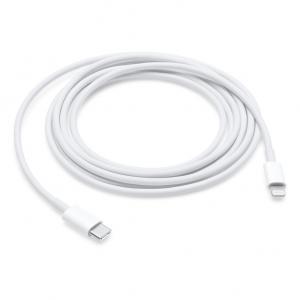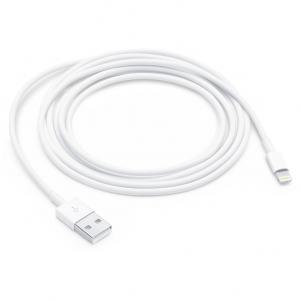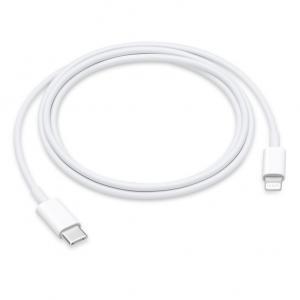Apple’s lightning cables are crucial accessories. They’re used to charge and sync your iPhone, iPad, or iPod touch, and they’re widely available from various sources. But with the rise of counterfeit products flooding the market, it can be difficult to distinguish between a genuine Apple cable and a fake one. Not only can counterfeit cables damage your device, but they also pose serious safety risks. In this article, we’ll share six foolproof ways to identify counterfeit Apple cables and keep yourself and your devices safe from potential harm. So whether you’re a seasoned Apple user or just starting out, read on to learn how to spot a fake Apple cable and distinguish them from the original.

The Importance of Spotting Fake Apple Cables
Spotting fake Apple cables is important for several reasons:
1. Safety Concerns
Fake Apple charging cables can pose a safety hazard. They may be poorly constructed, use substandard materials, or lack the safety features that genuine Apple cables have. This can increase the risk of fires, electrical shocks, and other safety hazards. In some cases, the use of counterfeit cables can even damage your device.
2. Compatibility Issues
Counterfeit Apple charging cables may not be compatible with your Apple device, which can result in charging issues or data transfer problems. This can be frustrating, particularly if you need to charge your device quickly or transfer important data.
3. Warranty Concerns
If your device is damaged as a result of using a counterfeit cable, it may not be covered under Apple’s warranty. Apple only provides warranty coverage for genuine Apple cables, so if you use a fake cable and it damages your device, you may be on your own.
4. Financial Loss
Fake Apple charging cables are often priced lower than genuine Apple cables, and this can be tempting for those who are looking to save money. However, purchasing a fake cable can end up being more expensive in the long run. If the cable damages your device or causes other issues, you may end up spending more money on repairs or replacement.
5. Legal Issues
Counterfeit Apple lightening cables are illegal and can result in legal issues. Selling or distributing counterfeit products is against the law, and those who do so may face legal consequences. Additionally, if you’re caught using counterfeit cables, you may face legal issues as well.
So, how do you tell if an Apple cable is genuine or not?
Let’s take a look at some of the easiest ways to tell the difference.
How to Identify Counterfeit Apple Cables: 6 Foolproof Ways
1. Check the Cable’s Packaging and Labeling
One of the easiest ways to spot a fake Apple charging cable is to check the packaging. Apple’s original packaging comes with a unique barcode, a serial number, and the Apple logo, which is embossed in high-quality printing. Additionally, Apple’s packaging is sealed with a plastic shrink-wrap that covers the whole box. Any signs of tampering or damage to the plastic wrap are an indication that the packaging may not be authentic.
Another crucial feature of Apple’s packaging is the text. Apple is known for its attention to detail and the quality of its products, which is evident in the packaging. The text on the packaging is clear and concise, with no spelling or grammatical errors. Any typos, misspellings, or grammatical errors on the packaging are red flags that the cable may be a fake.
2. Inspect The Cable Connector Pins
The next way to spot a fake Apple lightening cable is to inspect the connector pins. The connector pins are the metal pieces that make contact with your device when you plug in the cable. Genuine Apple cables have high-quality connector pins that are made of durable materials, and they fit securely into your device’s charging port. The connector on Apple’s lightning cable is relatively small, and it’s made of metal. The metal surface is smooth and has a matte finish, and it doesn’t have any visible seams or joints.

In contrast, counterfeit lightning cables have connectors that are often larger, made of plastic or cheap metal, and may have visible seams or joints. Additionally, the metal surface may not have the same matte finish as the original Apple cable. Sometimes, the connectors of fake lightening cables may have pins that are loose, bent, or damaged, which can cause your device to charge slowly or not charge at all. To check the connector pins of a cable, inspect them closely and make sure they’re straight and undamaged. You can also try plugging the cable into your device to see if it fits securely and charges correctly.
3. Check the Weight and Texture
Another way to identify a fake lightening cable is by checking its weight and texture. Apple’s lightning cables are made of high-quality materials that give them a specific weight and texture. Genuine Apple cables are heavy and sturdy, with a rubberized texture that feels comfortable in the hand.

In contrast, counterfeit cables are often lightweight and flimsy, with a plastic-like texture that feels cheap.
To check the weight of the cable, you can compare it to an authentic Apple cable. You can also gently squeeze the cable to feel its texture. A genuine cable will feel more substantial and sturdier than a fake one.
4. Check the Length of the Cable
One of the easiest ways to spot a fake Apple cable is to check its length. Genuine Apple cables have a specific length, and anything that deviates from that is likely to be fake. For example, genuine Lightning to USB cables are 1 meter or 2 meters in length. If you come across a cable that is shorter or longer than that, it is likely to be fake.
To check the length of the cable, you can use a ruler or measuring tape. Measure the cable from end to end and compare it to the length of a genuine Apple cable. If it is not the same length, it is likely to be fake.
One thing to keep in mind is that some counterfeit Apple cables may be of the same length as the genuine cables. In this case, you need to look for other identifying features to determine whether the cable is genuine or fake.
5. Check The Certifications and Regulatory Information
Apple’s cables are designed to meet specific regulatory standards, and they come with certifications that prove their authenticity. Genuine Apple cables have regulatory information and certification logos printed on the cable and packaging. The regulatory information includes details about the manufacturer, date of production, and the type of cable.
One of the certifications you should look for is the MFi (Made for iPhone/iPad/iPod) logo. The MFi certification means that the cable is Apple-approved and meets Apple’s performance and quality standards. If the cable you’re examining doesn’t have any regulatory information or certification logos, it’s likely a fake cable.
6. Test The Compatibility and Performance
Another way to spot a fake Apple cable is by testing its compatibility and performance. Apple’s lightning cables are designed to work seamlessly with their products, and they meet specific performance standards. On the other hand, counterfeit cables often fail to meet these standards, and they may not be compatible with your device or perform poorly.
To test the compatibility and performance of the cable, plug it into your device and try to charge or sync it. If the cable doesn’t work, or if your device displays a warning message, it may be a fake Apple cable. Additionally, if the cable charges your device slowly, intermittently, or if it doesn’t sync your data correctly, it’s another sign that it may be counterfeit.
Tips for Avoiding Counterfeit Apple Cables When Shopping Online
Shopping online for Apple cables can be convenient, but it can also be a breeding ground for counterfeit products. Here are some tips to avoid counterfeit Apple cables when shopping online:
1. Buy from Authorized Retailers
The best way to avoid counterfeit Apple cables when shopping online is to purchase from authorized retailers. Apple has an extensive list of authorized retailers on their website, and purchasing from one of these retailers ensures that you’re buying a genuine Apple cable. If you’re unsure if a retailer is authorized, check Apple’s website or contact their customer support.
2. Read Product Descriptions Carefully
When shopping online, make sure to read the product descriptions carefully. Look for any information about the cable’s certification under Apple’s MFi program, the warranty information, and the brand name. Counterfeit cables may use similar product descriptions, so it’s essential to read them closely to ensure you’re buying an authentic product.
3. Check Seller’s Reputation
Before making a purchase, check the seller’s reputation. Look for reviews and ratings from previous customers and read any feedback they have left. If the seller has a history of selling counterfeit products, it’s best to avoid buying from them.
4. Compare Prices
Compare the price of the cable to the price of a genuine Apple cable. If the price difference is significant, it’s likely that the cable is a fake. Counterfeit cables are often sold at a much lower price than genuine Apple cables, so be wary of deals that seem too good to be true.
5. Look for the MFi Logo
Genuine Apple cables will have the "Made for iPhone/iPad/iPod" (MFi) logo on the packaging and cable itself. If the product listing doesn’t show the MFi logo or the logo looks different from the official Apple logo, it’s a red flag that the cable may be fake.
6. Be Wary of Third-Party Marketplaces
Third-party marketplaces, such as eBay and Amazon, can be a source of counterfeit Apple cables. Be cautious when purchasing from these marketplaces and make sure to check the seller’s reputation, read product descriptions carefully, and compare prices. It’s also essential to be aware of the marketplace’s return policy and buyer protection policies in case you receive a counterfeit product.
Where To Buy Genuine Apple Cables
When it comes to buying genuine Apple cables, there are several options to choose from:
1. Apple Retail Stores
One of the most reliable places to purchase genuine Apple cables is directly from an Apple retail store. Apple stores offer a range of cables, including Lightning cables, USB-C cables, and Thunderbolt cables, and all of these cables are certified under Apple’s MFi program. Additionally, Apple stores offer a warranty on their cables, so you can have peace of mind knowing that your cable is covered if it’s defective or stops working.
2. Apple Online Store
The Apple Online Store is another great place to purchase genuine Apple cables. Like the retail stores, the online store offers a wide range of cables, and all of these cables are certified under Apple’s MFi program. Additionally, the online store offers free shipping on orders over a certain amount, and you can take advantage of Apple’s customer support if you have any questions or issues with your order.
3. Authorized Resellers
Apple has a list of authorized resellers on their website, and purchasing from one of these retailers ensures that you’re buying a genuine Apple cable. These resellers may include electronics retailers, department stores, or online retailers, and they offer a range of cables certified under Apple’s MFi program.
4. Best Buy
Best Buy is one of the largest electronics retailers in the United States and is an authorized reseller of genuine Apple cables. Best Buy offers a range of cables, including Lightning cables, USB-C cables, and Thunderbolt cables, and all of these cables are certified under Apple’s MFi program. Additionally, Best Buy offers free shipping on orders over a certain amount and a variety of payment options.
5. Amazon
While Amazon can be a source of counterfeit Apple cables, they also sell genuine Apple cables through their AmazonBasics brand. These cables are certified under Apple’s MFi program and are typically cheaper than purchasing directly from Apple. However, when purchasing from Amazon, it’s important to check the seller’s reputation and ensure that you’re buying a genuine product.
What to Do When You Find Out Your Apple Cable Is a Fake
If you realize that your Apple cable is fake, there are several steps you can take to rectify the situation:
1. Stop using the cable
The first step to take is to stop using the cable immediately. A fake cable can pose a safety hazard, and continued use of the cable could result in damage to your device or personal injury.
2. Contact the seller
If you purchased the cable from a third-party seller, reach out to them and inform them that the cable you received is fake. Request a refund or a replacement from the seller, and be sure to provide them with any evidence you have that the cable is fake, such as photos or a comparison with a genuine Apple cable.
3. Contact Apple
If you purchased the cable from an unauthorized seller or are unsure of its authenticity, contact Apple support. They can help you determine if the cable is genuine or not, and can provide you with information on how to obtain a replacement or refund if necessary.
4. Dispose of the cable properly
If you have determined that your cable is fake and are unable to obtain a refund or replacement, it’s important to dispose of the cable properly. Avoid throwing it in the trash, as it can pose a hazard to the environment. Instead, contact your local electronic recycling center to find out how to dispose of it safely.
How To Spot A Fake Apple Cable: Conclusion
Identifying counterfeit Apple cables is crucial for the safety and longevity of your devices. By following the six foolproof ways outlined in this article, you can easily spot fake Apple cables and avoid potential risks. Remember to always purchase from authorized retailers and check for common characteristics of fake cables. If you do end up with a suspicious cable, test it to ensure its authenticity before using it. By taking these precautions, you can protect your devices and enjoy the full benefits of genuine Apple cables.
See also: How to Spot Fake Apple Cables: 6 Ways to Ensure Authenticity
